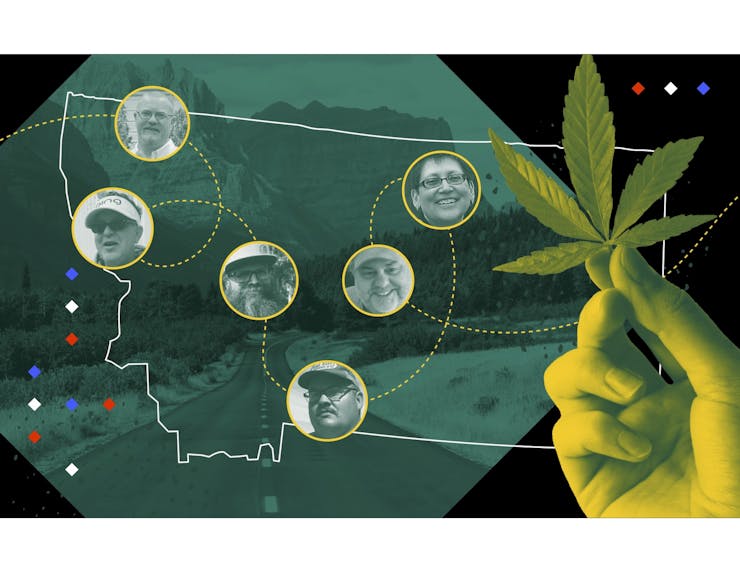Minutes after arriving at my front door in Missoula, Montana on a chilly afternoon in August, Pepper Petersen, the verbose political director of New Approach Montana, got the call he’d been waiting for. New Approach’s cannabis legalization initiative was officially on the November ballot.
How do you reach voters in a rural state the size of Germany? You hit the road.
Petersen, who was behind the wheel of his black Suburban at the time, responded with a whoop and an utterly unprintable exclamation of triumph.
Then he jumped into PR mode: “It’ll be on Reddit two days ago,” he muttered in his thick Memphis drawl.
Freedom and liberty on the ballot
Legalizing cannabis in Montana is a tricky affair. It actually requires two initiatives to pass: One legalizes adult-use cannabis and the other modifies the Montana state constitution to set the legal age for cannabis consumption at 21. The constitution defines an adult as someone 18 years or older, so the amendment is necessary to allow regulators to establish the higher minimum age.
The latest polls are bending in favor of legalization but the issue has long been a contentious one in Big Sky country.
In 2004, Montanans voted to legalize medical marijuana by a whopping 62%. Then the politicians stepped in and undermined the whole thing, repealing most of the measure through a bill that tip-toed through the state legislature in Helena. Court battles ensued. Dispensaries opened, then were closed, then opened again after voters passed another medical measure in 2016 that said, essentially, yeah we really meant it.
Pepper Petersen isn’t just advocating for an emerging industry. He’s asking his neighbors to cast a vote for the idea of Montana.
This year’s adult-use measure has been explicitly crafted to appeal to Montanans’ long-held love of rugged liberty, personal freedom, and the great outdoors. In a state where two-thirds of voters visit public lands more than six times every year, the new law proposes earmarking a large portion of cannabis tax revenue for public land conservation. If legalization passes, the legislature will have the final say regarding revenue allocation. Another portion of the tax would support military veterans, who make up nearly 10% of the state’s population.
The measure would also put the program in the hands of the Department of Revenue, a welcome alternative to the Montana Department of Health and Human Services, which oversees and has regularly bungled the medical program.
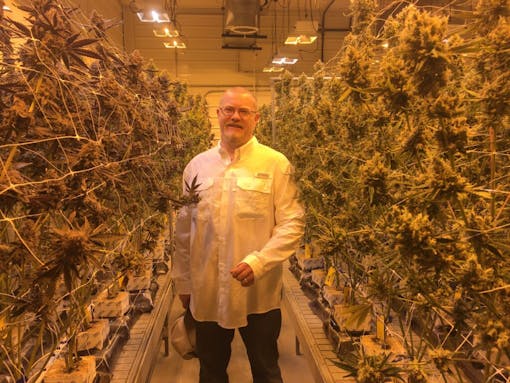
Steeped in the politics of Montana
Petersen is 42, wears transition lenses, and keeps his blond hair cropped close. To bring voters into his camp he draws on varied experience with past campaigns. While working as a major gifts officer at the NRA, for instance, he told me, “We were selling guns, but we were actually selling [the idea] of America.”
The same holds true with cannabis. Pepper Petersen isn’t merely advocating for the advancement of an emerging industry: He’s asking his neighbors to cast a vote for the idea of Montana.
A campaign that rose from the dead
I’d gotten to know Petersen over the phone this spring when still in Brooklyn, preparing for my imminent move to Missoula. Petersen was a news source, sure, but he also quickly became an unceasing fountain of unsolicited Montana advice—“You’re gonna want to buy a ‘99 Subaru Outback, green”—lyrical praiser of Montana’s natural beauty, and ridiculous storyteller of an upbringing in Tennessee.
When it came to the campaign, he had a lot to walk me through. In February, the state’s legalization campaign was cruising toward the ballot. Then came March—and the coronavirus pandemic.
Montana’s legalization effort was all but left for dead when state officials blocked New Approach from collecting signatures remotely. Then, in early May, campaign leaders instituted stringent safety measures to get canvassers back out on the streets. In a matter of days, they racked up thousands of signatures across the state and shocked the political world by making the November 2020 ballot.
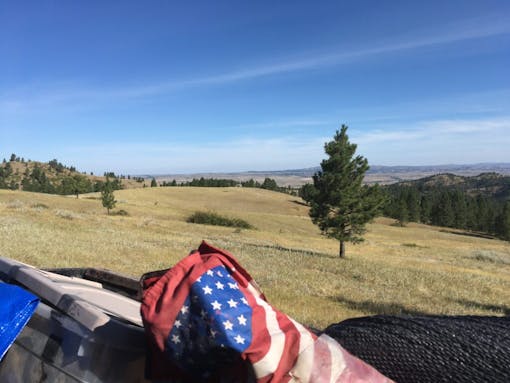
Let’s take a road trip—a really long one
Over time, Pepper and I cooked up a plan to see firsthand how the state’s medical marijuana dispensaries are prepping for the potential seismic change of legalization, and how Montana’s new “untethering” law—which allows medical patients to shop at any store instead of being stuck shopping at just one—is transforming the state’s industry.
Together we would drive across Montana—a state roughly the size of Germany—and investigate what a post-prohibition future could mean not only for Montana cannabis, but for the entire state economy.
Petersen had pitched the trip as a Fear and Loathing-style hedonistic odyssey and a look at the obstacles standing in the way of an equitable cannabis market. As I was soon to discover, he wasn’t exaggerating.
“We are gonna get wreckt towards an artistic and political purpose,” he texted me shortly before we hit the road. “Cannabis cowboys.”
Untethering dispensaries in Missoula
Missoula, population 75,000, and home to the state’s flagship university, was the first stop on our tour.
The city recently acquired a new superlative: It’s home to more dispensaries per capita than any other city in America. Our objective was to explore as many of them as possible to see how they’re adapting to untethering.
“Tethering” was Montana’s rule that required medical marijuana patients to register at one—and only one—dispensary. Shopping at any other dispensary was illegal. The rule made about as much sense as making people register at Chevron and forbidding them from gassing up at Shell, Texaco, or Arco.
Lawmakers finally ended the tethering rule in June 2020, to the relief of the state’s 38,000 medical marijuana patients.

Find your niche and thrive
In Missoula, dispensaries are carving out different niches to thrive in the new market. While Montana’s medical program tends to cater to patients with a need for high-dose products, some businesses are offering new low-dose options.
At Greenhouse Farmacy, an in-house brand of 5 mg gummies and 2.5 mg mints, called High Road Edibles, is luring in new customers. In the heart of town a couple blocks from the Clark Fork River, Zen Medicine slings edibles à la carte like a bakery. You want just two lozenges? We’ll pop ‘em out of the tray!
Other dispensaries have adopted a more, well, lived-in aesthetic. Trichome Valley, a spot on Front Street, has the feel of a college common room. Another dispensary in the same building, Silver Leaf, sells all pre-packaged products in a cramped space, like a human-operated vending machine. Petersen, however, was impressed with their Banana Kush.
While the challenges of standing out were evident in Missoula, we encountered a more urgent situation elsewhere.
Helena: The case of the disappearing customers
Next morning, we drove two hours east to the quiet capital city of Helena, where the state legislature sits in session only four months every other year and a mountain erupts dramatically out of the center of town. There we were joined by Ted Dick, New Approach Montana’s soft-spoken campaign manager and the former director of the state Democratic party.
On the outskirts of town we met Brian Nikkel, at his small craft dispensary, Keeper of the Green. The dispensary is next door to Nikkel’s home; the two are separated by a putting green. He wore a Ping golf visor the day we met. If there is a golf-and-cannabis market, Brian Nikkel owns it.
“Things were going good for us” under the state’s tethering policy, said dispensary owner Brian Nikkel. But tethering wasn’t so great for patients.
The tethered market served Nikkel well. He launched Keeper of the Green in 2017, after working as a grower for Bloom Montana, the state’s largest dispensary. Over time he amassed roughly 150 tethered patients. Most of his products fit in a single glass-fronted cabinet.
“Things were really good for us,” he told me. “They were steadily, slowly progressing in the right direction.”

When tethering died, so did part of his customer base. One-third of his business disappeared. Because his dispensary is so close to his home, Nikkel has been reluctant to put up street signage. He acknowledged that may need to change. To survive, Nikkel is considering investing in a storefront downtown, which would be a huge expense.
Nikkel was skeptical about the benefits of full legalization. “For a small provider like me it’s too much too soon,” he said. “There’s always a constant need to expand. I’m not looking to plaster a store in every part of Montana. That’s my choice. But even in Helena, rec will require a grow expansion to stay competitive.”
Local support in the new law
Brian Nikkel may not want to expand, but other dispensary owners do, and the adult-use legalization initiative gives them a chance to do so.
Many of the state’s 240 dispensaries are small operations. If both measures pass on Nov. 3, there will be a one-year moratorium on new licenses. That’s designed to keep big out-of-state companies from taking over the market. It could also give current providers a runway to grow and expand to meet the greater demand.
A spokesman made for Montana
As we drove east from Helena, I got a better sense of why Pepper and Ted are singularly suited to pitch legalization to their adopted home state.
Petersen has lived in the state for nearly 20 years. He’s enjoyed a varied career, running and working seemingly incongruous campaigns for Al Gore, Montana Conservation Voters, the National Rifle Association, and a coal industry association. Every politician and behind-the-scenes operator in Montana knows Pepper. With his booming voice and storytelling talent (as well as an occasional inability to know when his stories have run their course), he can pull nearly anyone into his orbit.
“He has the gift of gab,” a fellow cannabis enthusiast once told me with a mix of exhaustion and admiration, following one of Petersen’s marathon monologues.
A personal connection to the plant’s healing power
The healing power of medical marijuana is personal for Petersen. After contracting a debilitating kidney disease in the mid-2000’s, he embraced cannabis as a treatment for his chronic pain. Walk into any dispensary with him and Pepper will immediately announce his standing as one of Montana’s first 100 patients. The only thing he seems to consume more of than joints—preferably Blue Dream—is Dr. Pepper. He also manages a dispensary: Helena Buds’ Sanders Street location.
“I’ve always thought marijuana prohibition was bullshit,” Ted Dick told me. “This would be a harmless way to generate revenue for the state.”
In Ted Dick, Petersen has found an ideal political partner: the yin to his yang. Dick waits patiently, plots the campaign’s next moves, and leaves the talking to Petersen. Dick also does the driving.
The two have been crossing paths for nearly 20 years. “I’ve always called him for political perspective and the lay of the land when I was working out of state,” Dick explained.
“We balance each other out,” Petersen said of Dick. “Collectively, we probably know everyone in the state.”
While Dick is less of a consumer than Petersen, he’s just as committed to the legalization fight. “I’ve always thought marijuana prohibition was bullshit,” he told me. “I thought this would be a harmless way to generate revenue for the state.”
The legalization campaign, Dick added, “is the most fun one I’ve ever worked on.”
Belgrade: Dispensaries doubling in size
In Belgrade, a town ten miles outside Bozeman, we met Mike Singer, owner of Sensible Alternatives. The store was in the midst of an expansion. Singer is doubling the grow space and investing in sustainable LED lighting. “Untethering,” he told me, “has been outstanding.”
He attributes some of his success to a one-time policy enacted this spring, during Montana’s pandemic lockdown, that enabled medical patients to purchase their entire monthly allotment of five ounces in one day. The surge of pandemic buying wiped out his stock. “We’re only now rebounding from that,” he said.
Singer estimated that sales had increased 25% since untethering in June. He thinks a lot has to do with word-of-mouth advertising, since Montana law forbids him from advertising his wares in print or online without a password-protected website.
His location doesn’t hurt, either. Unlike Keeper of the Green, Sensible Alternatives is on a busy road, and Singer pays for a huge billboard that makes his operation hard to miss.
Singer is confident the expansion will serve him well in an adult-use market. If it’s not enough to keep up with demand “There’s room in the building to expand even further,” he noted.
Bozeman: Pushing the limits of a license
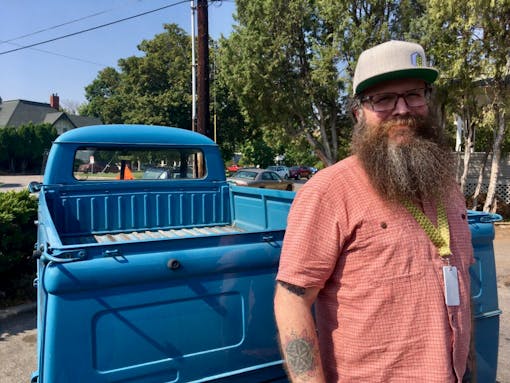
Down the road in Bozeman, workers at Spark1 were building a new greenhouse that will push the company to the 20,000 square foot limit of its licensed grow canopy.
Untethering and the expected coming of an adult-use market “go hand in hand,” said Marc Lax, CFO of Spark1.
“Right now our focus is on getting these greenhouses full,” said Lax. But even after this expansion is complete, he said, the company will need more space to serve the adult-use market. “If you don’t prep, you don’t survive,” he told me.
On the Northern Cheyenne Reservation: Finding a foothold
From Bozeman we headed further east still, out of the mountains, past the oil fields of Billings and into the flat, dry plains. Our destination was the Northern Cheyenne Reservation, 450 miles from Missoula.
We stayed on the reservation as guests of Republican State Sen. Jason Small, a member of the Northern Cheyenne tribe who is also the chairman of the Montana State-Tribal Relations Committee. Pepper Petersen is managing Sen. Small’s 2020 senatorial re-election campaign.
The tribe, with Small’s support, is scrambling to acquire a license to produce medical marijuana before the November election.
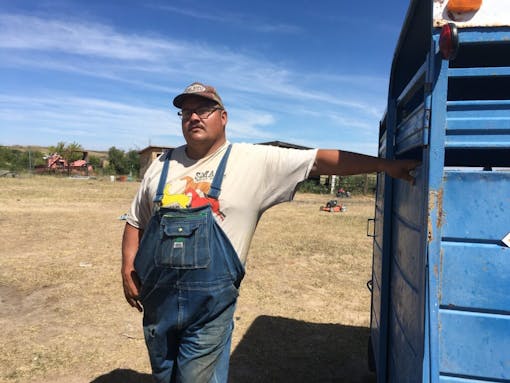
Crafting a state-tribal compact before the deadline
To do so, they will need to write a special compact, approved by the governor, that exempts them from federal law prohibiting cannabis production on reservation land. If they don’t meet that deadline, the one-year moratorium on new licenses would prevent them from getting a foothold in the market. A confounding tangle of state, tribal, and federal law stands in their way.
“There’s confusion and some points of contention” surrounding the legality of their venture, Small told me in his low, rumbling voice. “At the end of the day [Northern Cheyenne leaders] are going to look at what other tribes are doing and roll the dice.”
After greeting the state senator’s family, including Gretta, a rottweiler who shortly thereafter ate a porcupine, we headed down the road to meet some of the newly-formed Northern Cheyenne Cannabis Committee.
The informal conversation took place on a committee member’s property, where baled hay sat in a small green field, and a gaggle of dogs, pygmy goats and sociable cows kept us company.
Tough problems, job losses, and some hope in legal cannabis

The tranquil setting stood in stark contrast to the challenges tribal leaders described. Violence, drug addiction, and a lack of economic opportunity plague the reservation.
The nearby Colstrip coal-fired power plant is slowly shutting down, and with it go the jobs that helped keep food on the table. Shortly after our visit, Montana’s US senators wrote to the FBI demanding help with an ongoing spate of murders and abductions.
“Getting blocked out [of the adult-use cannabis industry] would be a travesty, especially given the social conditions that we face.”
– Carrie Branie, former member of the Northern Cheyenne Tribal Council
“There’s a big gap between what we could gain [from legalization], and what we could lose,” said Carrie Branie, a member of the Committee and a former member of the Northern Cheyenne Tribal Council. “We could stand to gain a lot not just dollar-wise but investment-wise in our own future with our youth, our cultural needs [and infrastructure projects],” she told me. “Getting blocked out [of the potential adult-use industry] would be a travesty, especially given the social conditions that we face.”
The possibility of capitalizing on cannabis is particularly enticing for the Northern Cheyenne considering their proximity to the Little Bighorn Battlefield National Monument, which draws more than 300,000 tourists in a normal year.
After the meeting, Petersen, Small, and I hopped in one of Small’s pickups and drove on rutted roads into the pine forest to camp. Small sang Hank Williams songs in a high, sweet voice as we cooked hot dogs on a copper wire.
Late that night, we sat and watched the lights of the Colstrip power plant flickering in the distance and I was again reminded of the economic power that legal cannabis can offer. As the power plant jobs disappear, cannabis jobs could replace those paychecks and provide experience in America’s fastest-growing industry.
Montana’s sink-or-swim moment
When I started writing about Montana’s medical marijuana market a year ago, I thought about it in extremely simplistic terms: Tethering bad, untethering good.
But things are never that simple. For all its absurdity, tethering also provided a support system for craft-scale growers like Brian Nikkel—folks who are passionate about cannabis and less interested in growing a business empire. It helped businesses off the beaten path retain customers despite their less-than-ideal locations. But it also limited a patient’s ability to find the right medicine to treat what ailed them—which is the whole point of legalization, after all.
What has happened already with untethering—and may continue if full legalization arrives—is nothing short of a sea change in a fragile market. It has offered new opportunities, but may also lead to the demise of companies that can’t keep up. In other words, Montana’s cannabis industry has entered a sink-or-swim moment.
That’s why, in advance of the election, Petersen and Ted Dick have launched the Montana Cannabis Guild, an industry association that aims to preserve and represent the state’s dispensaries, especially the little guys. While they can’t stop out-of-state companies from buying existing businesses, they can fight for those who remain independent and open.
“Montana is poised for explosive growth,” Pepper Petersen told me. When Montanans vote this November, “They’re going to be deciding for their families what’s best for Montanans, and that’s marijuana freedom.”
Read more about Montana’s push for legalization
- Election 2020: Montana cannabis legalization guide
- Election 2020: Marijuana legalization voter guide
- All about Montana’s marijuana laws
- Montana’s untethering rule comes to an end
